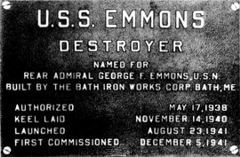

Emmons sailed from Norfolk 31 January 1942 on her shakedown to Callao, Peru, where she embarked Peruvian officers for Valparaiso, Chile, returning to Boston via several ports in Ecuador. She patrolled in New England waters, and in April escorted Ranger (CV-4) across the Atlantic to the Gold Coast, where the carrier launched Army fighter planes, brought for the base at Accra and other African air bases.
The summer of 1942 found Emmons patrolling out of Argentia, Newfoundland, and escorting troopships from Boston to Halifax. At Halifax on 5 July she joined an Army transport and a merchantman, whom she shepherded to a midocean rendezvous with a British escort unit to take them safely into Iceland. Emmons sailed on to join the British Home Fleet in Scapa Flow on 15 July. She underwent training necessary to coordinate American and British procedures and tactics. Between 26 and 31 July, she escorted the battleship HMS Duke of York to Iceland and back to Scapa Flow, then had convoy escort duty on the Scottish coast. On 17 August she cleared Scapa Flow for Iceland, where she made rendezvous with a convoy bound through the treacherous northern shipping lanes to Kola Inlet in the Soviet Union, from which she returned to Greenock, 30 August.
Name: United States Ship Emmons
Type: Destroyer
Namesake: Rear Admiral George Foster Emmons, USN
Navy Classification: DD 457
Class: DD 423, Gleaves
Authorized: 17 May 1938
Builder: Bath Iron Works Corp., Bath, Maine
Builder’s Hull Number: 188
Keel laid: 14 November 1940
Launched: 23 August 1941
First commissioned: 5 December 1941
Disposition: Lost: 7 April 1945
Emmons returned to New York 9 September 1942, and trained in Casco and Chesapeake Bays, and at Bermuda, for the invasion of north Africa, for which she sailed from Bermuda 25 October. She screened carriers covering landings at Safi between 8 and 13 November, returning by way of Bermuda and Norfolk to Boston. After brief overhaul and coastwise escort duty, she went to Cristobal to await a convoy to New York. Meanwhile she passed through the Panama Canal 9 January 1943 to train briefly with officers of the Ecuadorian navy. She guarded the passage of a convoy to north Africa in February, returning to New York 11 March for training. On 2 April Emmons put to sea via Argentia for Scapa Flow, where she joined the British Home Fleet again 19 May.
During the next 2½ months, Emmons joined in patrolling northern waters, guarding the movement of convoys across the North Atlantic, unceasingly alerted against the possible sortie of German ships from Norwegian bases. She also guarded British carriers in air attacks on Norway in July. Returning to Norfolk 9 August 1943, she voyaged to Gibraltar between 3 November and 19 December in the advance scouting line guarding Iowa (BB-61), carrying President Roosevelt to the Teheran Conference.
Between December 1943 and April 1944, Emmons guarded carriers during their operations at Newport and in Casco Bay, aiding in the training of aviators. On 20 April she sailed from Maine waters for the Azores, and Mers-el-Kébir, Algeria, arriving 1 May for antisubmarine patrols. On 17 May, her group teamed with British aircraft to sink the German submarine U-616, and the next day, Emmons sailed for England, and final preparations for the invasion of France, 6 June. After guarding pre-assault minesweeping, she joined in the heavy bombardment prior to the landing. She remained off the beachhead for 3 days as watchdog for the vast armada of ships lining up with men and supplies, then retired across the Channel to Plymouth, England, screening Texas (BB-35). Returning to the assault area 11 June, Emmons served in the screen guarding transports and supply ships from submarine attack. After replenishing at Portland, England, from 21 to 24 June, she kept watch around battle ships and cruisers during the bombardment of Cherbourg, 25 June.
Emmons returned to Mers-el-Kébir on 10 July 1944 with a transport convoy she had brought across from Portland, then had escort duty in the Mediterranean ports preparing for the assault on southern France. She sailed from Taranto, Italy, for the beachheads on 11 August and on the 15th began pre-invasion bombardment. She remained off the beaches all day to provide fire support to troops storming ashore. Escort duty took her away to Italian and Corsican ports, but she returned to patrol off the French Riviera until October.
Emmons put into Boston 9 November 1944 for conversion to a high-speed minesweeper, and after Atlantic training and exercises in the Hawaiian Islands, entered Ulithi to stage for the invasion of Okinawa. Her squadron put to sea 19 March 1945 for the dangerous, vital task of clearing Okinawa’s waters to let assault ships close the beaches for the landings of 1 April. She then took up picket duty and on 6 April, during one of the first of the massive kamikaze attacks, was a target as she sailed with Rodman (DMS-21). One of the first planes to attack struck Rodman, and as Emmons circled the stricken ship to provide antiaircraft cover, both DMS’s were overwhelmed by suicide-bent Japanese planes. Many were splashed, but Emmons was struck by five, almost simultaneously. One hit her fantail, the rest to starboard of her pilot house, of No. 3 gun mount, on her waterline, aft, and the port side of her combat information center. Crippled and ablaze, with ammunition exploding wholesale, Emmons found damage control a desperate, losing struggle. That day her gallant crew, who had already won the Navy Unit Commendation for Okinawa, lost 60 dead, 77 wounded. The rest had to abandon ship. Next day, the 7th, the hulk was sunk to prevent its falling into enemy hands.
In addition to her Navy Unit Commendation, Emmons earned four [sic] battle stars for World War II service.